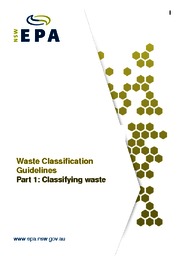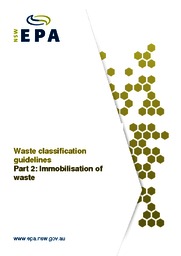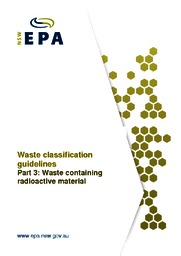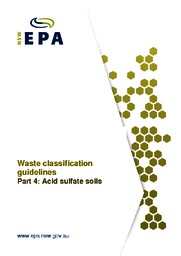Waste Classification Guidelines
- Part 1: Classifying waste (PDF 599KB)
- Part 2: Immobilising waste (PDF 310KB)
- Part 3: Waste containing radioactive material (PDF 296KB)
- Part 4: Acid sulfate soils (PDF 299KB)
- Addendum to Part 1: Classifying Waste (PDF 60KB)
General classification principles
The following principles apply when using the step-by-step waste classification process.
- Where practicable, safe and appropriate, it is desirable to separate a mixture containing different classes of wastes before classifying them separately. For example, if waste tyres (special waste) are mixed with lead-acid batteries (hazardous waste), it would be desirable to separate the wastes so only the hazardous component is classified as hazardous waste.
- Two or more classes of waste must not be mixed in order to reduce the concentration of chemical contaminants. Dilution of contaminants is not an acceptable waste management option. This includes the addition of water to any waste prior to laboratory analysis for the purpose of waste classification.
- When classifying waste using chemical assessment it is not appropriate to exclude sample results. Selectively choosing sample results to classify waste introduces bias and violates fundamental statistical principles. For example, where a waste has been chemically assessed ‘in situ’, and the waste is excavated and chemically assessed as a stockpile, both in-situ and stockpile analytical results are to be used in classifying the waste. There must be scientifically valid reasons for the exclusion of sample results.
Guidelines Part 1: Classifying waste
Part 1 of the Waste Classification Guidelines (PDF 599KB) explains six basic steps for classifying your waste. In brief, these steps are
Step 1
Establish if the waste is classified as special waste.
Step 2
If the waste is not classified as special waste, establish whether the waste is classified as liquid waste.
Step 3
If the waste is not classified as special waste or liquid waste, establish whether the waste is of a type that is ‘pre-classified’.
To simplify the classification process, a number of commonly generated wastes have been pre-classified as either hazardous, restricted solid, general solid waste (putrescible) or general solid waste (non-putrescible) in the waste classification definition section of Schedule 1 of the Protection of the Environment Operations Act 1997 (POEO Act).
Step 4
If the waste is not classified as special waste, liquid waste or pre-classified (as set out in Step 3), establish if the waste has certain hazardous characteristics and therefore is classified as hazardous waste.
These hazardous characteristics are set out in the definition of ‘hazardous waste’ in Schedule 1 of the POEO Act, and in Step 4 of Part 1 of the Guidelines.
Step 5
If the waste has not been classified after Steps 1 to 4, it should be chemically assessed to determine whether it is hazardous, restricted solid or general solid waste (putrescible or non-putrescible). If the waste has not been classified after Steps 1 to 4 and is not chemically assessed under Step 5, it must be classified as hazardous waste.
Step 6
If the waste is chemically assessed under Step 5 as general solid waste, a further assessment is available to determine whether the waste is general solid waste putrescible or non-putrescible. The assessment determines whether the waste is capable of significant biological transformation. If the waste is classified as general solid waste under Step 5 and this assessment is not undertaken, it must be classified as general solid waste (putrescible).
Rules for using the guidelines
In using the Waste Classification Guidelines to classify waste, the following rules apply
- The steps for waste classification must be applied in the order presented above.
-
Once a waste’s classification has been established under a particular step, do not go to the next step.
The only exception to this is where special waste is mixed with restricted solid or hazardous waste. In these circumstances, the waste must be classified as special waste and restricted solid or hazardous waste, and managed as both of those classifications.
Otherwise, mixed waste must be classified according to the highest class of waste. For example, if a non-liquid waste contains three contaminants (other than asbestos, tyres or clinical and related waste) and only one of these contaminants is present at the concentration specified for hazardous waste, the waste must be classified and treated as hazardous waste.
- If an immobilisation approval applies to a waste, a generator who complies with the terms of that approval may classify that waste as set out in the approval, rather than the Waste Classification Guidelines.
Guidelines Part 2: Immobilising waste
Part 2 of the Waste Classification Guidelines (PDF 317KB) deals with immobilising waste.
Some wastes with high levels of contaminant(s) are not suitable for disposal to landfill in NSW. However, sometimes the contaminants are able to be 'immobilised' so they will not be released into the landfill leachate at levels of concern. The EPA can grant an immobilisation approval in these cases, allowing a waste to be reassessed and reclassified. Compliance with an immobilisation approval would enable a waste to be disposed of at a landfill appropriate to its reclassification.
Guidelines Part 3: Waste containing radioactive material
Part 3 of the Waste Classification Guidelines (PDF 296KB) deals with waste containing radioactive material.
Waste containing any natural or artificial substance that emits ionising radiation spontaneously must be classified on the basis of its radioactive characteristics.
Guidelines Part 4: Acid sulfate soils
Part 4 of the Waste Classification Guidelines (PDF 299KB) deals with acid sulphate soils.
Acid sulfate soils (ASS) are naturally occurring sediments and soils which contain sulfides, mainly iron sulfide and iron disulfide or their precursors. ASS are most commonly found in NSW along the coast and when excavated, they need to be managed appropriately to avoid significant environmental harm.
Generators of excavated material should review the applicable Acid Sulfate Soil Risk Maps (available online from the CSIRO) to determine the probability of ASS being present at the site at which excavation is proposed. Printed Acid Sulfate Soil Risk Maps are also available for viewing at the offices of relevant local councils. Chemical assessment may be required to determine the presence of ASS.





